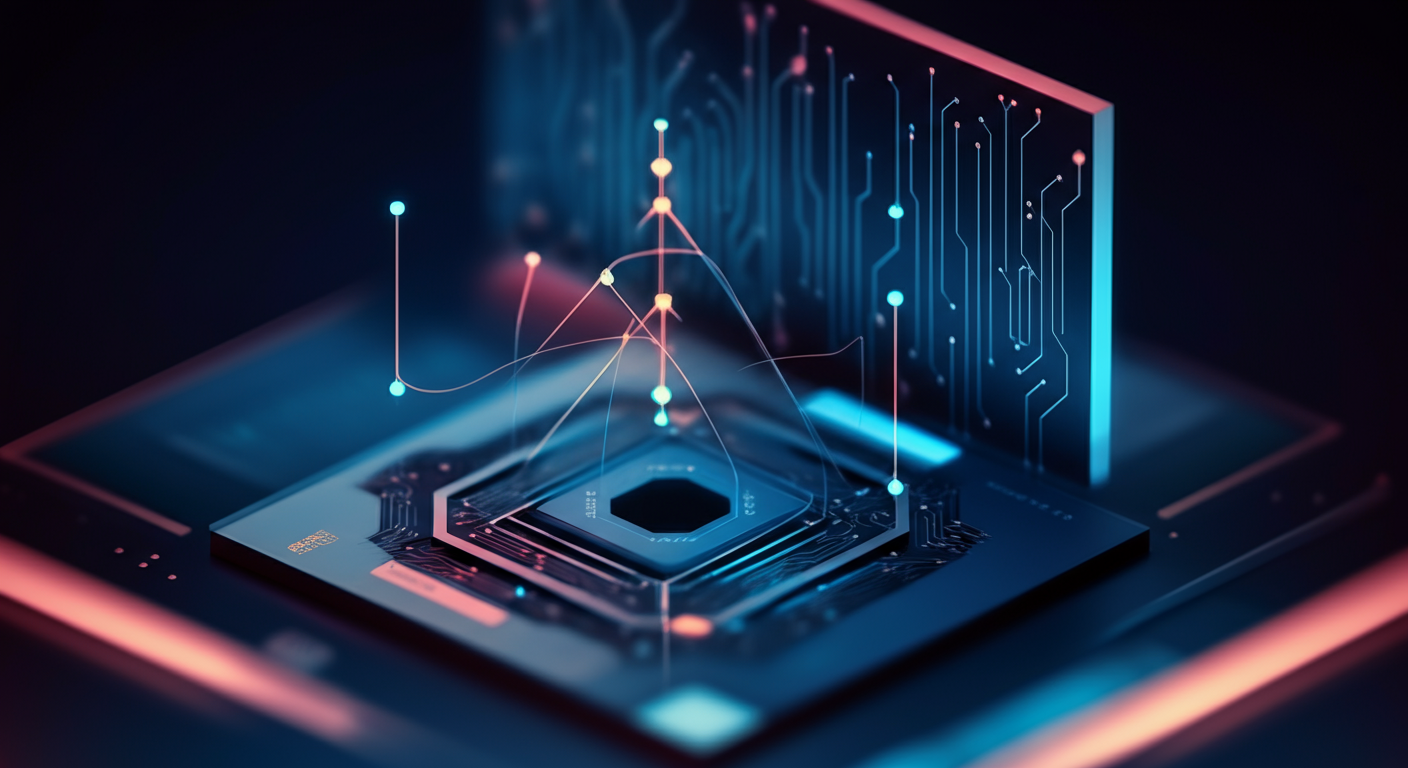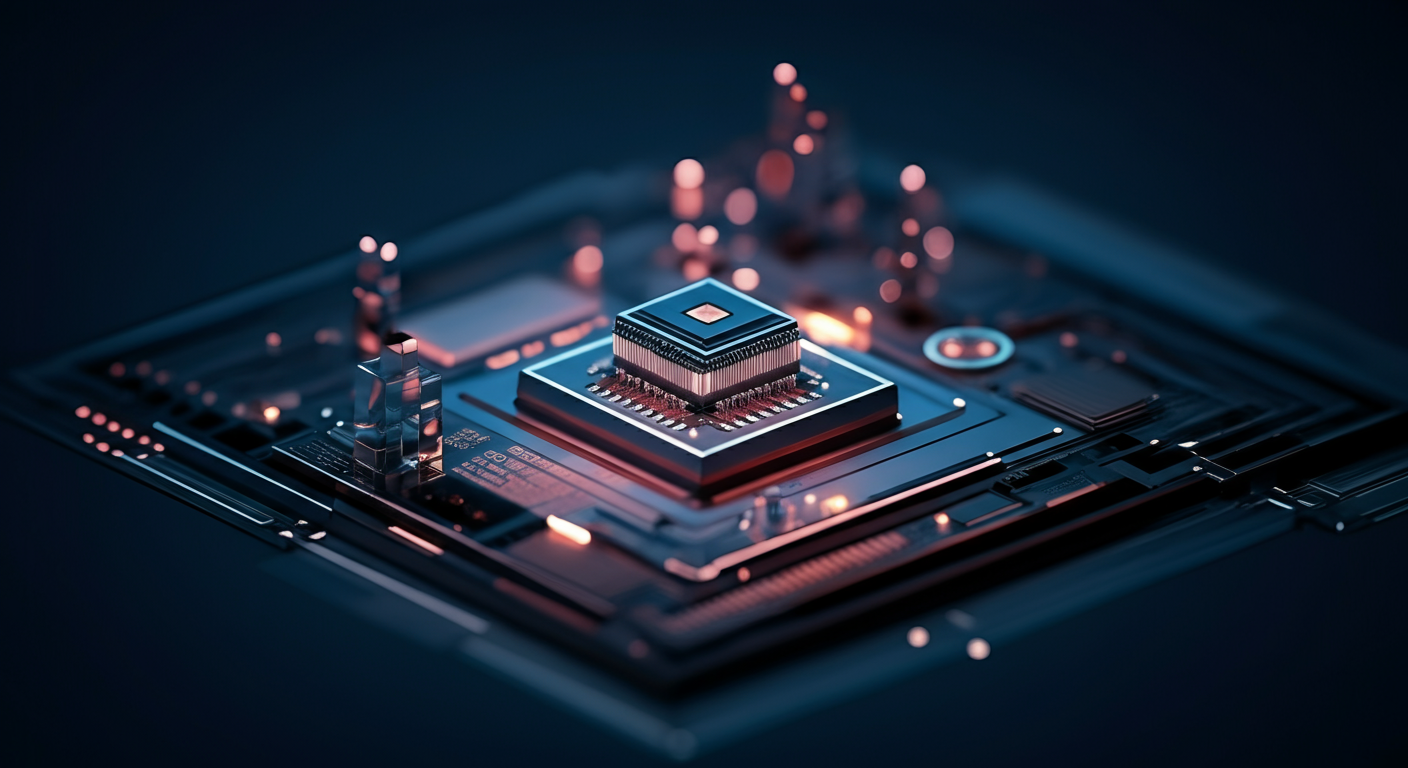Low-Latency AI: A Deep Dive into Edge Inference for Speed, Privacy, and Efficiency

Understanding Low-Latency AI and Its Importance
Low-latency AI refers to artificial intelligence systems designed to deliver results with minimal delay, often crucial for real-time applications. It's about getting AI inferences at lightning speed.
The Need for Speed: Real-Time Applications
Low-latency AI is becoming increasingly critical in various sectors.- Autonomous Vehicles: For self-driving cars, split-second decisions can be life-saving. Low latency ensures immediate responses to changing road conditions.
- Finance: High-frequency trading requires instant analysis and execution. The faster the AI inference latency, the bigger the competitive edge.
- Healthcare: Real-time diagnostics and patient monitoring demand rapid analysis of medical data, enhancing patient outcomes.
Latency, Accuracy, and Computational Cost: The Balancing Act
Optimizing for low-latency AI involves trade-offs:- Latency vs. Accuracy: Reducing latency sometimes means simplifying models, which can impact accuracy.
- Computational Cost: Achieving ultra-low latency often requires more powerful hardware, raising computational costs. Tools like BentoML help to optimize model inference.
Quantifying the Impact: User Experience and ROI
Minimizing AI Inference Latency directly affects user experience and business outcomes.
- Improved User Experience: Faster response times lead to more engaging and satisfactory user experiences. Think interactive AI assistants or gaming.
- Increased ROI: In industries like finance, reduced latency translates to increased trading volume and profitability. In healthcare, faster diagnosis means quicker treatment and reduced healthcare costs.
Here's how edge computing is revolutionizing AI by slashing latency.
The Rise of Edge Computing for AI Inference
Edge computing emerges as a game-changing solution to minimize the AI inference latency. Instead of relying solely on centralized cloud servers, edge AI pushes computation closer to the data source, be it a smartphone, a smart camera, or an industrial sensor.Cloud vs. Edge: A Latency Showdown
| Feature | Cloud-Based AI Inference | Edge-Based AI Inference |
|---|---|---|
| Computation Location | Remote data centers | Directly on the device or local server |
| Latency | Higher due to network transit | Significantly lower |
| Privacy | Data traverses the internet | Data processing remains local |
| Bandwidth Costs | Higher, especially with video data | Reduced bandwidth usage |
| Offline Capability | Limited | Fully functional even offline |
Edge computing brings processing power where it's needed, eliminating reliance on distant servers and their associated delays.
Advantages of Edge Computing
- Lower Latency: Critical for real-time applications like autonomous driving and robotic surgery.
- Increased Privacy: Sensitive data stays on the device, reducing the risk of interception.
- Reduced Bandwidth Costs: Processing data locally minimizes the need to transmit large volumes over networks.
- Offline Capabilities: Edge AI operates even without an internet connection.
Why Cloud Isn't Always King
For applications demanding near-instantaneous response times, such as controlling industrial machinery or enabling augmented reality experiences, cloud-based AI inference simply can't keep up. With Edge AI, actions are performed without cloud services, opening a range of possibilities.Ready to dive deeper? Check out our AI Glossary to master key AI terms and stay ahead of the curve.
Low-latency AI, particularly edge inference, is rapidly transforming how we interact with technology, impacting everything from autonomous systems to personal data privacy.
Benefits of Edge Inference: Speed, Privacy, and Reliability
- Speed: Edge AI significantly reduces latency. Instead of sending data to a remote server, processing happens directly on the device. This eliminates network hops, crucial for time-sensitive applications. Think of an autonomous drone navigating a complex environment; instant decision-making is paramount.
- Privacy: Edge inference enhances data privacy. By processing data locally, sensitive information doesn't leave the device, mitigating the risk of interception or data breaches. This is especially important for privacy-conscious users.
- Reliability: Edge AI offers improved reliability. Because it can function offline, edge inference is resilient to network outages. Imagine a smart camera used in industrial automation that needs to function continuously, regardless of network availability.
Real-World Applications
Edge inference is powering innovation across industries:
- Autonomous Drones: Real-time decision-making in navigation and obstacle avoidance.
- Smart Cameras: Instant object detection and security alerts without cloud dependence.
- Industrial Automation: Predictive maintenance and quality control with minimal downtime.
Security Considerations
While edge inference offers enhanced privacy, it introduces new security challenges. On-device AI can be vulnerable to physical attacks or data extraction. Mitigations include hardware-level encryption, secure boot processes, and robust authentication mechanisms. Ensuring secure edge AI is paramount for widespread adoption.
Edge inference delivers a compelling combination of speed, privacy, and reliability, making it a pivotal technology for the future of AI and a gateway to applications requiring real-time responsiveness and data security. Continue exploring how AI is changing different sectors in our AI News.
Low-latency AI at the edge is rapidly becoming essential for applications demanding speed, privacy, and efficiency.
Techniques for Optimizing AI Models for Low-Latency Edge Deployment

Several techniques can be employed to optimize AI models for low-latency deployment on edge devices, balancing model size, speed, and accuracy.
- Model Quantization: Reduce model size and improve inference speed using techniques like Quantization Aware Training and Post Training Quantization. Model quantization converts floating-point numbers to integers, making computations faster and models smaller for devices with limited resources.
- Knowledge Distillation: Train smaller, faster models by transferring knowledge from a larger, more complex model. This process, known as knowledge distillation, can dramatically reduce model size while retaining much of the original model's performance.
- Model Pruning: Remove redundant or less important parameters from the model through model pruning.
- Efficient Neural Network Architectures: Use neural network architectures specifically designed for resource-constrained environments, including MobileNet and EfficientNet. These architectures are optimized for efficiency without sacrificing too much accuracy.
- Model Compression Techniques: Several Model Compression Techniques are used to make models smaller and faster. These includes quantization, pruning, and knowledge distillation, all aimed at deploying models on devices with limited compute resources.
Unlocking the power of low-latency AI requires a strategic approach to hardware.
The Need for Speed: Hardware's Role in AI Inference
Specialized hardware accelerators are crucial for speeding up AI inference, especially at the edge. Inference is the process of using a trained AI model to make predictions on new data. Think of it as the "doing" phase after the "learning" phase of AI.- GPUs (Graphics Processing Units): Originally designed for graphics processing, GPUs excel at parallel processing, making them suitable for many AI tasks.
- TPUs (Tensor Processing Units): Google's TPUs are custom-designed for machine learning, offering optimized performance for tensor operations.
- NPUs (Neural Processing Units): NPUs are specifically built for neural network computations, aiming for efficiency and speed in AI tasks.
Performance & Power: A Balancing Act
Different hardware platforms offer varying levels of performance and power efficiency.- High-end GPUs and TPUs provide the highest performance but consume significant power.
- NPUs and optimized FPGAs often strike a better balance between performance and power, ideal for edge deployment.
FPGAs: Customizable Acceleration
FPGAs (Field-Programmable Gate Arrays) stand out because their hardware architecture can be reconfigured after manufacturing, allowing fine-tuned acceleration for specific AI models and workloads.FPGAs are particularly useful where flexibility and customization are paramount, but can require specialized expertise to program effectively.
Edge AI Integration
Integrating AI accelerators into edge devices enables on-device inference.- Smartphones: Modern smartphones often include NPUs for accelerating AI tasks like image recognition and natural language processing.
- IoT Devices: From smart cameras to industrial sensors, AI accelerators enable real-time data processing and decision-making at the source.
Specialized hardware is no longer optional but a strategic necessity for achieving low-latency AI inference, enabling faster, more private, and more efficient AI solutions. Next, we'll explore software optimization techniques to further boost AI performance.
Low-latency AI at the edge offers transformative possibilities, driving advancements in speed, privacy, and efficiency.
Frameworks for Edge AI Development

Several frameworks and tools are available to streamline the creation of low-latency AI applications for edge devices. These tools abstract away much of the complexity associated with optimizing and deploying models on resource-constrained devices.
- TensorFlow Lite: A lightweight version of TensorFlow designed for mobile and embedded devices, enabling on-device machine learning inference, reducing latency, and improving privacy. Find more information on TensorFlow Lite.
- PyTorch Mobile: Extends the PyTorch ecosystem to mobile, allowing developers to deploy PyTorch models on edge devices with optimized performance and a streamlined deployment process. This tool is designed for edge AI deployment with model optimization in mind. You can learn more about similar tools in Software Developer Tools.
- ONNX Runtime: A cross-platform inference and training accelerator compatible with various frameworks like TensorFlow and PyTorch. It allows you to run models in the ONNX format, optimizing them for different hardware platforms.
Simplifying Deployment and Benchmarking
Containerization using tools like Docker simplifies deployment by creating consistent environments.
Docker packages applications and their dependencies into containers, ensuring reproducibility and portability. This is useful in deploying models across diverse edge devices with varying system configurations. For resources related to setting up your AI workflows, see Learn.
Profiling and benchmarking tools analyze model performance on edge devices, identifying bottlenecks for optimization. For example, it's important to understand the differences between TensorFlow Lite vs. CoreML vs. ONNX Runtime and their effect on your model.
Ready to take your AI to the edge? Leveraging these frameworks and tools provides a solid foundation for developing low-latency, privacy-focused, and efficient AI applications tailored for edge devices.
Overcoming the Challenges of Edge AI Deployment often feels like navigating a minefield.
Resource Constraints and Power Consumption
One of the biggest edge AI challenges is the limited compute resources and memory available on edge devices. Unlike cloud servers, edge devices are typically resource-constrained, demanding careful optimization to deploy complex AI models."Consider a smart camera using AI for object detection. The camera needs to perform inference quickly without draining the battery, requiring a model tailored for its specific hardware."
- Model compression techniques (quantization, pruning) become crucial.
- Power consumption and thermal management also loom large. You can’t just throw more processing power at the problem because these devices must operate efficiently, often in harsh conditions.
Data Heterogeneity and Distribution Shifts
Handling data heterogeneity is another significant hurdle. Edge environments are diverse, with varying data formats and quality across different devices. Distribution shifts – where the data patterns change over time – can also impact model accuracy.- Robust data preprocessing pipelines are essential.
- Techniques like transfer learning and domain adaptation can help models adapt to new environments.
Security and Reliability
Edge AI security is paramount. Sensitive data processed on edge devices must be protected from unauthorized access.- Encryption, secure boot processes, and intrusion detection systems become critical.
- Robustness is equally important, systems need to be reliable and fault-tolerant, ensuring continuous operation even in challenging conditions. The AI Glossary can help you learn more AI terms.
Low-latency AI is rapidly evolving to meet the demands of a new generation of applications.
Growing Demand in Emerging Applications
The metaverse and augmented reality are driving an increased need for AI responsiveness, creating opportunities for innovation in AI solutions like ChatGPT that requires near-instantaneous interactions.Real-time experiences in the metaverse demand split-second AI decision-making.
- Metaverse & AR: Low latency crucial for natural interactions.
- Autonomous Vehicles: Real-time processing prevents accidents.
- Robotics: Precise control requires instant command execution.
Neuromorphic Computing
This approach mimics the human brain, potentially leading to incredibly efficient and fast AI processing, which would be transformative for applications needing ultra-low latency.- Event-Driven Processing: Reduces energy consumption.
- Parallel Computation: Speeds up complex calculations.
- Adaptive Learning: Improves efficiency over time.
Advancements in AI Hardware and Software
Innovations in both areas are crucial for reducing latency, including specialized chips and efficient model architectures that improve the speed and efficiency of AI.- TinyML: Allows machine learning on embedded systems.
- Efficient Model Architectures: Reduce computational load.
- Specialized Hardware: Accelerates AI tasks.
Convergence of AI and 5G/6G Technologies
The partnership between AI and next-gen wireless networks promises to enable real-time applications that demand minimal delay, creating significant opportunities for AI in practice.- High Bandwidth: Enables faster data transfer.
- Ultra-Reliable Low Latency Communication (URLLC): Ensures stable connections.
- Network Slicing: Optimizes resource allocation for specific applications.
The Future of Edge AI
As edge computing evolves, expect to see significant impact across industries as AI processing moves closer to the data source, enhancing privacy, speed, and efficiency.- Enhanced Privacy: Data processed locally reduces transmission needs.
- Reduced Latency: Faster response times enhance user experience.
- Increased Efficiency: Optimized resource usage lowers costs.
Keywords
low-latency AI, edge computing, edge AI, on-device AI, AI inference, model optimization, hardware acceleration, TensorFlow Lite, PyTorch Mobile, AI deployment, real-time AI, privacy-preserving AI, offline AI, efficient neural networks
Hashtags
#LowLatencyAI #EdgeComputing #AIInference #OnDeviceAI #AIHardware
Recommended AI tools

Your AI assistant for conversation, research, and productivity—now with apps and advanced voice features.

Bring your ideas to life: create realistic videos from text, images, or video with AI-powered Sora.

Your everyday Google AI assistant for creativity, research, and productivity

Accurate answers, powered by AI.

Open-weight, efficient AI models for advanced reasoning and research.

Generate on-brand AI images from text, sketches, or photos—fast, realistic, and ready for commercial use.
About the Author

Written by
Regina Lee
Regina Lee is a business economics expert and passionate AI enthusiast who bridges the gap between cutting-edge AI technology and practical business applications. With a background in economics and strategic consulting, she analyzes how AI tools transform industries, drive efficiency, and create competitive advantages. At Best AI Tools, Regina delivers in-depth analyses of AI's economic impact, ROI considerations, and strategic implementation insights for business leaders and decision-makers.
More from Regina

